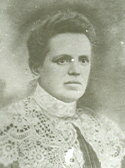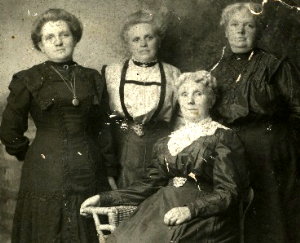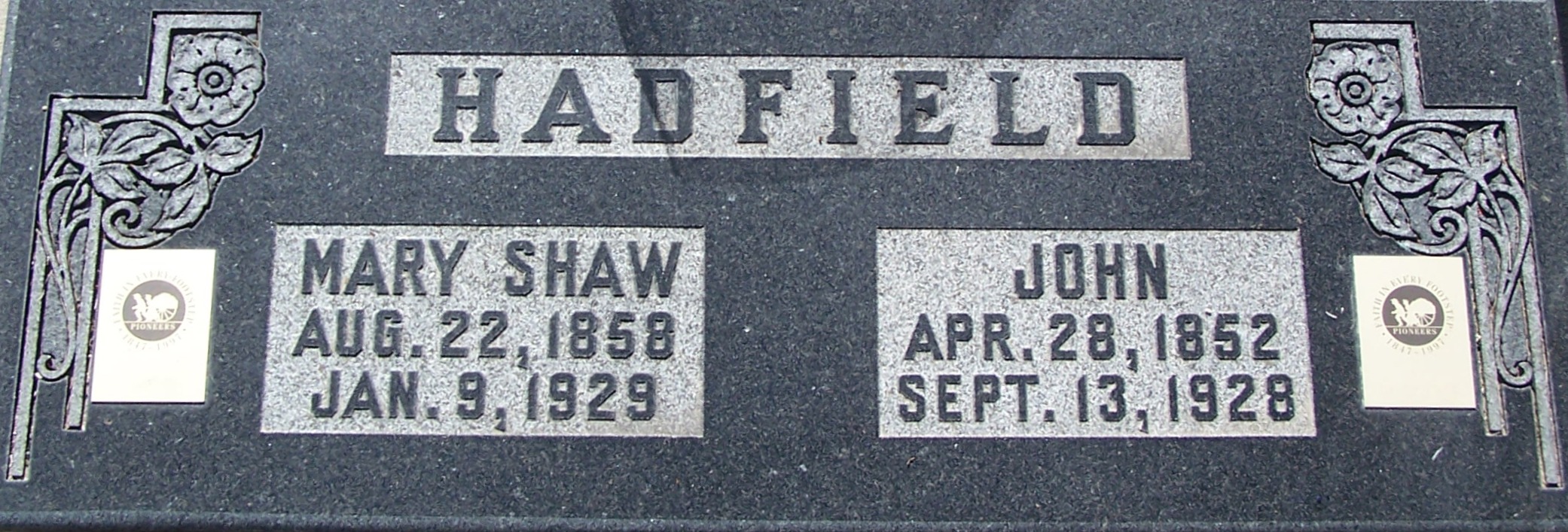 Mary Shaw Hadfield was born at Mellor, Derbyshire, England, on August 22, 1858. Mary was the daughter of William Shaw and Elizabeth Morton. She was raised with her four brothers and three sisters in a small mining community called Mellor, her birthplace.
Mary Shaw Hadfield was born at Mellor, Derbyshire, England, on August 22, 1858. Mary was the daughter of William Shaw and Elizabeth Morton. She was raised with her four brothers and three sisters in a small mining community called Mellor, her birthplace.
While she was still very young, the Mormon missionaries brought the Gospel to their home. The Shaw family accepted the Gospel and as each child became of age, they were baptized. They were scorned and ridiculed for their beliefs. Sometimes one of the “Anti-Mormon” groups would dress up to represent the Prophet Brigham Young and his forty wives and would parade through the streets in front of their homes. Persecution became so great that it became difficult to hold meetings without being disturbed, so they were held at the Shaw home.
William Shaw prayed for many years to come to America and to join the Saints in Utah. His eldest daughter, Ellen had already immigrated with her husband, James R. Simpson. The Shaw family finally managed to save enough money for William Shaw and his son, Edwin, to come to America. The rest of the family remained in England waiting for their father to earn enough money to send for them.

Clara Frost, Mary Hadfield, Ellen Blanthorn & Maggie Douglas
In the meantime, Mary had grown into a young woman and had moved to Glossop where she obtained employment in a large cotton factory as a “twister.” Here she met the young overseer who was later to become her husband. They were married and made their home in Glossop where their first child was born. The baby, a girl, was named Mary Elizabeth after her two Grandmothers.
Mary’s father had sent money for the family to come to America leaving Mary behind. Mary’s husband, John Hadfield, and his family never knew that Mary was a member of the LDS church, better known as the Mormon Church. Johns’ family were members of high standing in the Church of England and Mary would have been an outcast in the Hadfield family. She kept this secret until years later when she had the privilege of coming to America to join her family.
John and Mary lived in one of the houses owned by John’s grandfather, Christopher Hadfield. They lived in the middle of three houses on Weskey Street. There were three large bedrooms upstairs, a kitchen, dining room, and a large parlor downstairs. The parlor was a well-kept room with beautiful furnishings. Children were not allowed in this room, even when company came. However, the living or dining room and the adjoining kitchen was different. This was where the family ate, studied and lived together. The kitchen had a large stone sink where the dishes were washed and a huge fireplace built into the wall with a bake oven on one side and a small tank on the opposite side for heating water. There was always plenty to eat and the family members enjoyed good social standings.
Mary longed to see her parents and family again. It had been some time since they had gone to the United States. Her brother-in-law, George Blanthorn, came to England as a missionary for the LDS Church and was encouraging them to come to America. Perhaps the deciding factor in their decision to come was an incident in the factory where John worked. The overseers were on strike and the management accused John of favoring the cause of the strikers and the strikers said he was favoring the management’s cause. He became angry and quit his job and he declared, “It’s over the briny ocean for me.” Mary, thinking this was the answer to her prayers, went to work making preparations for the journey and before John changed his mind.

Left to Right – William, Mary Elizabeth, John, Mary Shaw, John, Amy, Jessie & Clara Hadfield
After disposing of their lovely furnishings and priceless belongings, they bid farewell to their many friends and acquaintances and on May 11, 1900 they boarded a train for Glasgow, Scotland and on the next day boarded the City of Rome, the finest ship afloat, for the city of New York.
The crossing was very difficult for Mary. She was ill during the entire voyage and the ship’s doctor feared for her life. One night she had a dream and saw very clearly her father who had come to America many years before. He was preaching to the congregation and quoting a great deal of scripture. Some weeks later, in Northwestern Utah, she attended her first meeting in the new country and saw her father again and heard him preach and quote from the scriptures as she had seen and heard him in her dream.
After about fourteen days the boat docked in the New York harbor. The family stayed there overnight and the next day boarded a train for Utah. The ride across the United States was strange and different. When they arrived in Ogden, Utah they stayed for a few days with Lizzie Boyle, a cousin of Mary’s father. The final part of the trip was from Ogden, around the Great Salt Lake to a small railroad town called Terrace. Here the family was met by Willie Shaw, Mary’s brother. A team and wagon provided the transportation from the train to the community of Grouse Creek about forty miles northwest, where they were to make their new home, arriving about the middle of June.
There were about thirty-five families scattered over a wide area in this little community. A two-room log house with a dirt roof and a few essential pieces of furniture had been provided and the family was soon settled and trying to make the best of everything. The oil paintings, bedding, tablecloths and the family Bible that had been tucked away in the trunks when they left England helped to make the log cabin more livable.
Words can never describe the feelings of loneliness, disappointment and despair that came to the weary travelers as they looked out over the vast, barren, uninhabited, desolate country. They wondered what power had moved them to leave the beautiful green hills and fields of England for this wilderness.
Soon the family was able to move into a larger and more comfortable home near the church.
Since the records were either lost or not recorded, on August 13, 1900, Mary was rebaptized and her three oldest daughters were baptized into the Mormon Church. The other members of the family who were of age were baptized the following year.
John found work as a janitor, while the older children were doing odd jobs and Mary was helping to nurse the sick. Things were looking up for the family and they now felt that perhaps their move to the West was for the best. Later, the family worked with livestock and began to homestead and get land and a home for themselves.
There was a great need for someone who could render nursing service and care for the sick and Mary was asked by the Relief Society to go to Salt Lake City and take a course in obstetrics. This she did and finished the training very successfully. She lived at the home of President Charles W. Penrose, a counselor to President Joseph F. Smith, and studied and practiced with Dr. Romona B. Pratt, whose first husband was Parley P. Pratt. She received her medical diploma on October 4, 1904.
She was given the opportunity to remain in Salt Lake City to practice medicine, but she chose to return to Grouse Creek. She devoted years of unselfish service to the people there and in the adjoining communities in Idaho and Nevada. She was loved and cherished by everyone for her devoted service. Some families paid what they could afford. Others paid nothing. She never asked for pay for her services and never sent out bills. She stated that the services she rendered to people in need brought her the greatest joy in life.
One of the miracles of her career was the way she cared for her granddaughter Nadine Simpson, who was born prematurely. She kept the tiny baby in cotton padded shoe box in an oven where she adjusted and maintained the proper temperature constantly for several days and nights.
Mary Shaw Hadfield passed away on January 9, 1929 and she is buried in the Grouse Creek Cemetery.

